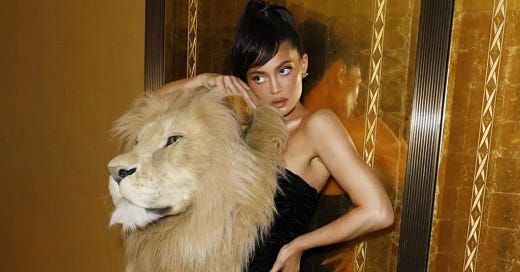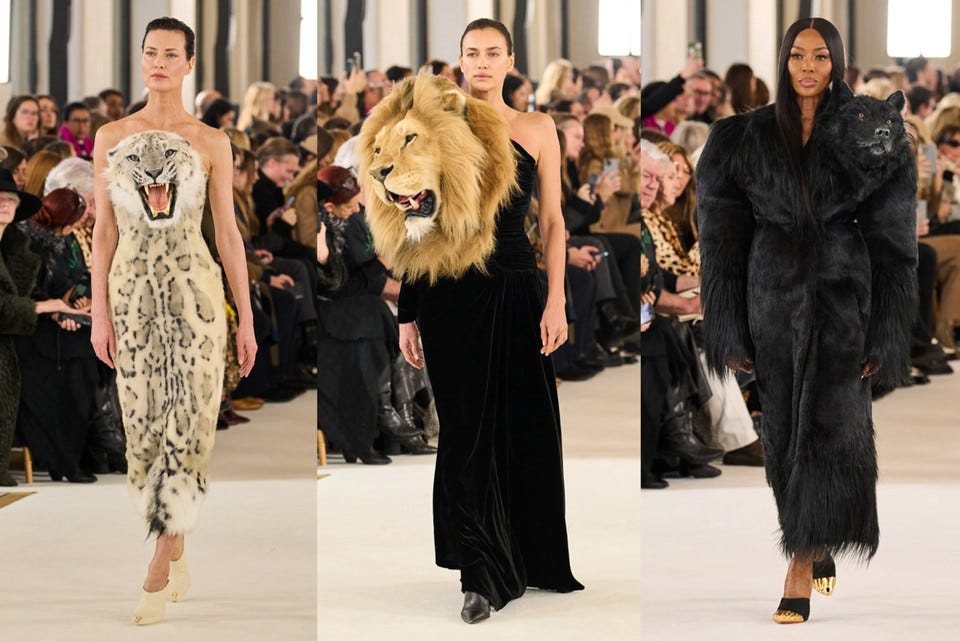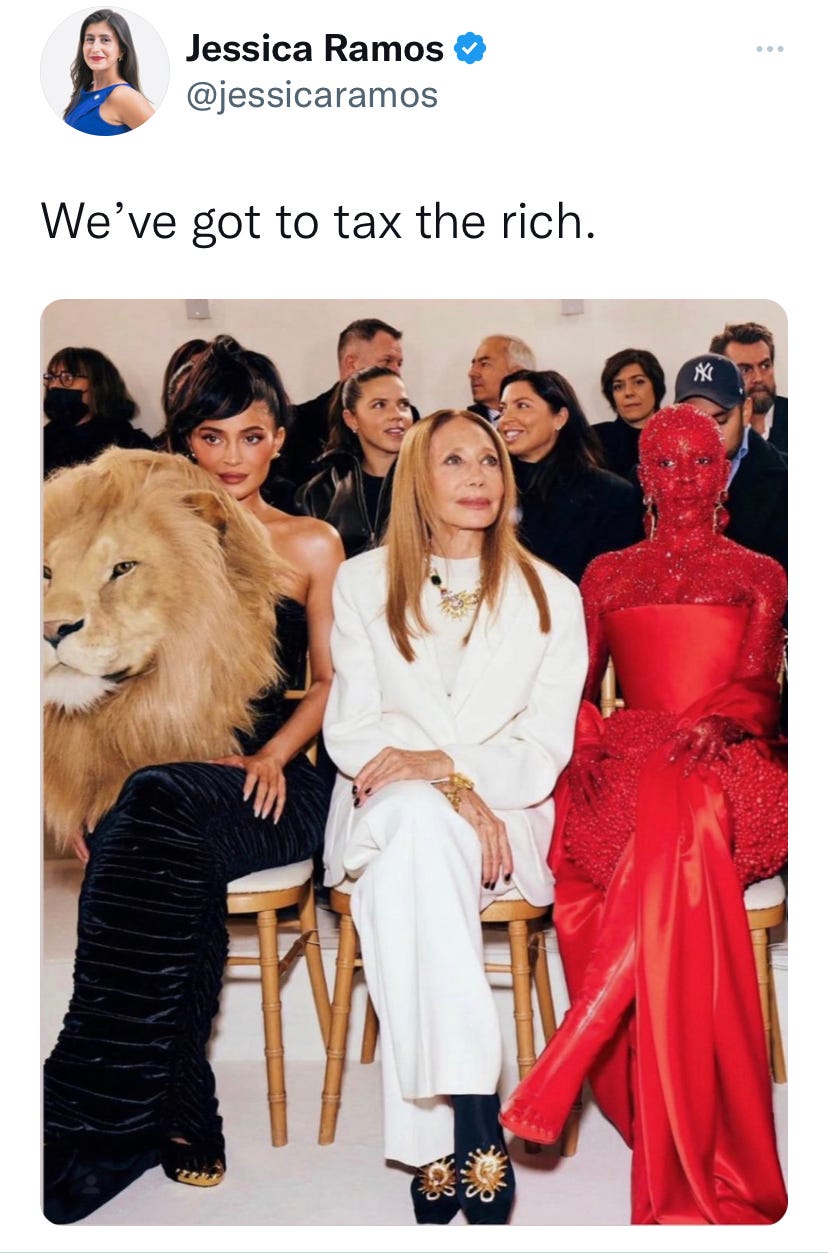Another Stuffed Animal Fashion Controversy, So Soon?
The realistic plushies in Schiaparelli's latest show spark outrage of the internet variety
By T. Bloom
Hot on the heels of last year’s Balenciaga scandal (covered here by JUDGEMENT’s Eric Shorey) comes yet another tempest over animal effigies in the fashion world. Daniel Roseberry’s realistically-detailed megafauna were a standout among the many looks on parade at Schiaparelli’s Inferno couture runway show in Paris, with Kylie Jenner leading the charge in a breastplate that may conjure memories of riding the escalator at FAO Schwartz.
The fashion world is well aware that the public’s perception of this artform and its patrons is generally NOT GOOD, and for decades designers have counted on superficial, knee-jerk responses to make headlines. If your collection isn’t outré enough to be misunderstood, then did it accomplish anything?
And yes, the desire to provoke this predictable response often causes artists to sail far past any point of grace, exposing them to be legitimately just as bad (if not worse) as any Zoolander-esque stereotype the public is eager to project upon them. In which case, the system works… I guess?
This invisible tipping point of outrage was surely on Roseberry’s mind when he crafted the artistic statement for these detailed faux-taxidermy looks, which he claims were inspired by lines from Dante’s Inferno: “The leopard, the lion, and the she-wolf—representing lust, pride, and avarice.”
In this context, one can hopefully appreciate the meta-commentary of dressing up someone like Jenner in a garment representing cosmic punishment for the sin of pride. Through that lens, even the visual comparison to hunting trophies raises pretty stark questions related to the moral corruption inherent to the pursuit of beauty and wealth.
But as a 21st century designer, Roseberry also knows that most onlookers will never read his artistic statement, or will only encounter those words in the aftermath of a hurt or angry response after having these images flashed at them via social media or tabloid journalism, eliciting Rorschach test responses: some will see the designers’ attempt to glorify nature, others will see a continuation of humankind’s drive to exploit and destroy it. Here’s where the comparison to Balenciaga is apt, I believe — the ambiguity and resulting outrage are definitely part of the floor show.
The true test of a designer’s talent has always been twofold: the ability to court and anticipate predictable forms of backlash, followed by the ability to resist/outlast it and emerge unscathed. This is, quite simply, how artists demonstrate their power to transcend tastes, attitudes, and limitations of their time. And this proving ground is so littered with prominent failures — especially since the advent of social media — the value placed on success is even greater, and artists strain further and further to attain it.
In my opinion there should be a third test, one that measures the quality of the outrage. After all, it’s pretty easy to draw backlash from animal rights folks and child abuse watchdogs; there certainly isn’t anything brave or original about pushing those buttons, and historically these activists have proven they have good reason to keep a close eye on the fashion industry. So that’s where I think these Schiaparelli designs score lowest, counting on superficial responses, poor-faith reads, and tender-hearted sensitivities in order to go viral.
But that still doesn’t change the fact that art and artists are increasingly scapegoated for not just “promoting” harmful ideas, but causing actual harm in ways that are impossible to prove or quantify, and thus also impossible to atone for.
We seem to demand that artists walk that tightrope for us, perhaps unconsciously hoping to see them fall. Art that doesn’t edgily engage with Serious Issues is criticized as out-of-touch, indistinguishable from pure entertainment for the masses or an aesthetic plaything for the wealthy. However, it’s also become increasingly difficult for a work to draw attention to serious issues in intelligent, creative ways without being instantly misunderstood as part of the problem it was created to address.
One quick example is the horror genre’s depiction of mental illness. At a panel I hosted on the subject some years ago, a number of artists described how portraying these kinds of horrifying scenes had been a helpful form of catharsis, allowing them to articulate very real horrors they’d survived during their personal struggles; for many audience members, these depictions serve as a way of facing their worst fears, of safely exploring the dark places they feel discouraged from talking about. Through art, through horror, they find a sense of connection with others. But this is far from a universal experience, and many have argued that horror movies and media unfairly stigmatize mental healthcare, or perpetuate misunderstandings about mental health conditions. When there is no clear consensus, whose evaluation of “harm” matters most?
Over the past decades, horror and fashion have frequently been found in bed together. And their provocations have been further complicated by the fact that some artists really are bad people — or at least bad artists — and even the good ones have their blind spots. Most high-visibility art is created by entire teams of people, which can diffuse accountability in conversations about who is to blame for its problematic elements. By the time a high-flying concept ends up boiled down to an Instagram post (ultimately for the purpose of advertisement, let’s not forget) for literally anyone to engage with, it’s very easy to lose track of which provocations are defensible, or even worth tolerating.
Does the Schiaparelli show “promote” trophy hunting, or cruelty to animals? Roseberry’s quotes about the intent of his show suggest the opposite, and the detail and craftsmanship that went into these stuffies is representative of how far fashion artists are willing to go to spare further damage to wild animal populations, if indeed likenesses of these creatures must be reproduced to satisfy the tastes of the wealthy and insipid. Which, apparently, they must! Because we are literally in hell.
As with the Balenciaga scandal, there are no clear victims here to advocate on behalf of. No animals were harmed, and one can’t realistically posit that a new generation of poachers and trophy hunters will be awakened, Manchurian Candidate-style, by a single runway show that will be forgotten about by next week. But the urgency and intensity of the reaction has continued to snowball, shaping this into conversation that everyone feels confident leaping into — because harming animals is bad isn’t actually a controversial opinion, and nothing is risked by voicing it in front of folks who largely agree with you… even if no animals were actually harmed.
Despite the staggering amount of hurt and anger directed at Schiaparelli (again, powered largely by the news media, who never met a silly fashion scandal they didn’t like), it appears PETA has landed on the side of the artists, explaining to TMZ:
“[The look] celebrates lions’ beauty and may be a statement against trophy hunting, in which lion families are torn apart to satisfy human egotism… These fabulously innovative three-dimensional animal heads show that where there’s a will, there’s a way.”
That’s another difficult truth to consider in the midst of any firestorm: public opinion is rarely as black-and-white as any presented narrative would have one think, often creating strange ideological befellows as the discourse unfolds. It’s impossible to agree with PETA and Christie Brinkley about this one, so who do you choose? Does one’s hatred of Kylie Jenner demand that one overlooks Schiaparelli’s rich tradition of surrealism drawn from animal forms? And is it even possible to meaningfully criticize an art form that notoriously provokes and then resists criticism?
I’d say the conversation about the conversation is where fashion continues to thrive as a relevant art form. The designers themselves rarely face their critics; however, the rest of us have to face each other on a regular basis, and reach an understanding that allows us to move onward together through one ethical conundrum after another.
It’s unfortunate (for us) that so much of that discussion happens in a depersonalized way, in the comments under an Instagram post or TMZ article, but by now this is so deeply ingrained in the fashion world’s presentation of itself, they’re certainly not coming to rescue or illuminate us anytime soon. Perhaps the best a successful designer can do in 2023 is create a show that effectively communicates “LOL, we’re so fucked,” to see who accepts the challenge, what ends up being formed in response.
And if all it generates is Sad/Angry Reacts, then we really are fucked. Commenting on a post or article about a risky design is itself a kind of fashion choice, isn’t it? A quick way to demonstrate awareness of brands, issues, politics, or even just basic human nature, in front of other people. And then we all move on… to what? Next week will bring another example of prominent figures making the kind of “mistakes” we insist are easy to avoid… from the toilet, where we sat for several minutes longer than necessary, tapping and scrolling our way through this divine comedy.
That’s right, sweetie: it turns out rage-tweets at Schiaparelli or Balenciaga are just another form of fast fashion. We’re all in this Inferno together, and too many of us are looking down at the stars.
***
If you’ve enjoyed reading this free post, why not subscribe for more JUDGEMENT? Sign up to have free content delivered straight to your inbox, or pay $5 for regular *exclusive* content! Thank you for enduring this sales pitch.







